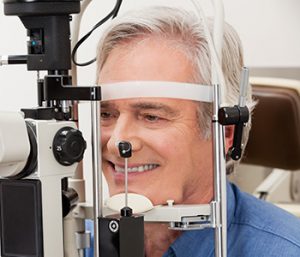
Glaucoma is a serious and common eye condition that most often impacts patients over the age of 60. Because it can occur gradually and without obvious symptoms, many patients don’t consider that they might have glaucoma until they begin to notice changes in vision. However, vision loss that occurs because of glaucoma cannot be restored. Therefore, Dr. George Salib of Orange County Eye Institute in Laguna Hills urges his patients to be monitored for glaucoma and begin treatment immediately to prevent loss of vision. Glaucoma is a disease that impacts the optic nerve within the eye. It typically occurs when fluid builds up in the eye, causing increased pressure. There are two types of glaucoma: With primary and chronic angle-closure glaucoma, patients often don’t notice any immediate symptoms. As the disease progresses, they may notice an inability to see in their peripheral vision, often called a blind spot. However, an acute angle glaucoma attack will bring on rapid symptoms including sudden blurry vision, severe headache or eye pain, nausea, or rings/halos in the vision. A patient who experiences these symptoms should seek treatment right away, as it can cause blindness. Glaucoma can happen to most people. Some patients may have an increased risk of contracting glaucoma. For example, patients who have a family medical history, have high eye pressure or have had a previous eye injury should be monitored closely. Additionally, those with thin corneas or who have a thin optic nerve also have increased risk. Finally, patients who do not have eye issues, but have other risk factors such as diabetes, migraines, high blood pressure, or poor circulation can also be at increased risk. While patients who experience symptoms may suspect glaucoma, the only way to confirm the disease is with an eye exam. During this exam, the doctor will measure the pressure in your eye, examine the eye’s drainage angle, cornea, and optic nerve, and test your peripheral vision. Glaucoma cannot be reversed, but it can be controlled with proper treatment. Medication, in the form of eye drops, can lower the amount of pressure in the eye by reducing the fluid in the eye or helping it flow better to the drainage angle. Patients can also consider laser surgery that will help the eye drain fluid properly. It’s important to note that patients have an important role to play in their glaucoma treatment. Eye drops must be administered properly and on schedule and patients should plan to visit their eye doctor regularly for checkups. For more information about glaucoma treatment, contact the Orange County Eye Institute at (949) 770-1322.What is glaucoma?
What are the symptoms of glaucoma?
Who is at risk for glaucoma?
CALL OUR OFFICE FOR MORE INFORMATION
(949) 441-5444 How is glaucoma detected?
How is glaucoma treated?
Share This Article
Back to Glaucoma Page










